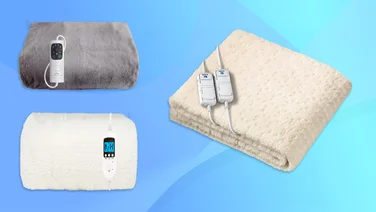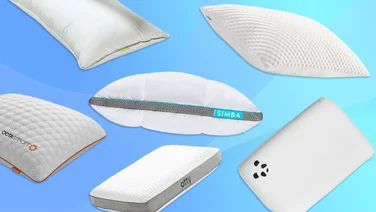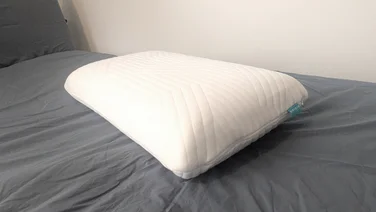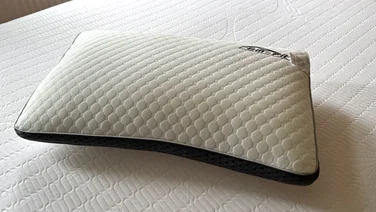To help us provide you with free impartial advice, we may earn a commission if you buy through links on our site. Learn more

Given you’ll be spending a third of your life wrapped up in your duvet, it’s pretty vital that you select the one that’s right for you. There are many factors to consider when buying a duvet, including size, temperature, weight, material, quality, care and maintenance, among other things. We’ve asked the experts to give their insight into how to choose a duvet that you’ll want to snuggle up with night after night.
Read on for our comprehensive guide on choosing the right duvet for you, with tips on which tog ratings to look out for, how to spot good quality design, and which materials to prioritise if you’re prone to allergies. And for some more specific recommendations, see our roundups of the best duvets and best winter duvets to buy.
Measure up
“Choosing the right duvet starts with making sure you have the correct bed measurements,” says Hafiz Shariff, founder of Owl + Lark. Duvets are generally made to fit the same size as your bed i.e. a double bed will require a double duvet. If you’re unsure though, whip out the tape measure – Shariff recommends opting for a duvet that’s slightly larger than your mattress (around 30cm more all round) to ensure it covers you properly while ensuring there’s not too much excess hanging over the edges. However, there may be some instances in which you’d want to upsize. If you share a bed with someone who’s a bit of a duvet hogger or you personally prefer more drape, you may want to go a size up. The other reason may be if you’re particularly tall: you don’t want cold feet during the night!
Think about tog ratings
A duvet’s tog rating determines to a great extent how warm it will be. The rating system ranges from 1 to 15, with higher numbers offering greater insulation. Choosing the right tog rating is mostly a matter of personal choice, but there are some rough guidelines around which tog may be best depending on the season you’re buying your duvet for. “For summer, duvets with a tog rating of 2.5 to 4.5 are ideal, while winter typically calls for options between 10.5 and 13.5 togs,” explains Shariff.
An all-seasons duvet, however, can cover all bases, which allows you to fasten a summer and mid-weight tog together (usually a 4.5 tog and a 9 tog) to make one warmer duvet for the chilly winter months. It’s worth noting that you may want to choose a lower tog rating if you’re a hot sleeper, perhaps going through menopause, or have skin conditions such as eczema that may be aggravated by heat.
For more information, we have a more detailed article dedicated to explaining tog ratings.
Try the Scandi sleep method
If you share a bed with a partner, you might have trouble deciding on a tog rating. If one of you is prone to kicking off the covers and the other prefers a toasty duvet, ‘splitting up’ could be the answer. “The Scandinavian sleep method is where a couple share a bed, but each person has their own individual duvet to help get the best night’s sleep possible,” explains Jonathan Warren, bedding expert and director of Time4Sleep. “The freedom to customise your duvet while co-sleeping is a great solution for couples who have different sleep needs. Both people can regulate their body temperature better, and avoid disrupting their partner if they toss and turn.”
Don’t forget fill power
If you’re considering a down duvet, it’s worth looking at its fill power. The fill power is basically a measurement of how much space an ounce of down filling will occupy. The higher the fill power, the ‘loftier’ the duvet will be. A loftier duvet can trap more air, leading to better insulation, warmth and fluffiness. “The EU fill power scale goes from 0-900, although the most common down products have a rating of 400 to 500,” explains Nils Stene, CEO of Norvegr. “These are considered to be relatively low quality, however, as they come from immature geese and ducks with smaller down clusters. When purchasing a high quality down duvet, you should look for a fill power rating of at least 600. Down with a fill power of 800+ is extremely good. 850 is the highest quality that is consistently available.”
Account for allergies
If you’re prone to allergies, a down duvet might not be for you. You may at least need to look for duck down and feather options with anti-allergy treatments such as Nomite and Biome finishes, which can create a natural barrier against dust mites. For another natural alternative, wool is a great hypoallergenic option. “Wool’s natural properties make it resistant to dust mites, mold, and mildew, and can help with allergies and asthma,” explains Chris Tattersall, sleep expert at Woolroom. Synthetic duvets are also an excellent choice for those with allergies as they tend to be resistant to dust mites and can be washed easily at high temperatures. It’s best to look for those labelled as ‘hypoallergenic’ or ‘anti-allergy’ when buying your duvet.
Assess the quality
“High-quality materials are essential to avoid overheating and to ensure consistent warmth, comfort, and durability throughout the winter,” reveals Danielle Mason, head of product development at The Fine Bedding Company. Mason explains that cheaper fillings often use excess hollowfibre, leading to stiffness and bulkiness, while higher-quality duvets use innovative fibres – such as Smartfil, explained in more detail on The Fine Bedding Company’s website – that provide lightweight warmth and better temperature regulation, supporting restful sleep. The craftsmanship of the duvet itself is equally essential. “Diamond-shaped quilting or a baffle-box design prevents the fill from shifting, eliminating cold spots and ensuring an even warmth that stands up to daily use,” adds Andrew Seed, managing director at The Odd Company. “Lastly, look for a silky, pure cotton casing with piped and double-stitched edges – a refined finish that elevates both durability and aesthetics.”
Consider the materials
We’ve already touched on the fact that the material makeup of your duvet can affect the quality and durability of the product, as well as whether it’s suitable for allergy sufferers. But there are also other factors at play, such as breathability, the weight and feel of the duvet, and how tricky it is to care for. “For optimal breathability, it’s best to choose a natural duvet,” says Mark Tremlett, founder of Naturalmat. “Duck and goose down duvets are exceptionally soft and comfortable, with a lightweight quality that makes them feel wonderfully airy. Another great option is wool, which works wonders in the winter months at keeping you toasty, but releases the heat when it gets a little too warm, making it a great all-rounder.”
However, as Danielle Mason points out, synthetic duvets have their advantages too: “They’re much lighter than natural materials, which can increase airflow during the night, plus they’re also the better option for washability, as feathers don’t handle water well and must be treated carefully during cleaning.”
Make sure it’s practical
Speaking of washing, the level of care your duvet requires might help you decide whether it’s the one for you. If you want a low-maintenance duvet you can bung in the washing machine and tumble dryer, then a synthetic option is probably best. Some wool duvets are washable but not all, so it’s worth checking before you buy. Down and feather duvets as well as silk designs are most likely going to require professional cleaning, so consider whether you’re prepared for the upkeep before you invest.
Ensure it’s ethically sourced
“If you are looking for an ethically sourced duvet with natural filling, you can check for brands that have the certifications to confirm their product is produced ethically,” says Jonathan Warren. For example, when buying a down duvet, be sure to check the product label or packaging for one of these accreditations: The Responsible Down Standard, Global Traceable Down Standard, Downpass or Downmark. “This is so that you can be assured that the feather and down products you are buying have been produced without causing distress to the geese,” adds Attwood. He also warns against buying from brands that say they use Hungarian goose down but don’t provide guaranteed traceability.
When it comes to other natural materials, such as wool, look for the Global Organic Textile Standard (GOTS) label, which ensures animal welfare and sustainable farming practices throughout the supply chain. Also check to see if the duvet has an Oeko-Tex 100 certification, which ensures no harmful toxins or chemicals have been used. You could opt for synthetic alternatives, but if you do, try to look for those that have been made from PET plastics, and check to see if the manufacturer promotes sustainable practices.
What other mistakes do people make when choosing a duvet?
“You should also check with the brand you are purchasing from if they have a return policy so you can send your duvet back if you are not happy with it,” says Warren. Look for ‘sleep trials’ where you can test out the duvet for a number of days before committing and also check whether it has a decent guarantee, especially if it’s a pricier duvet.
Don’t forget to look at the customer reviews: there may be insights into the product that are very revealing, such as whether people complain that the duvet is too ‘rustlely’ to sleep under or smelly (poor-quality feather duvets may have a slightly unpleasant odour). And of course, read our own duvet reviews too.
In an ideal world, try and view the product in person before you buy if the seller has a physical shop; you may find the duvet is much weightier than you realised, for example. While some people prefer the secure, heavy feeling, some others may find it claustrophobic and too hot. Equally, if you were expecting something substantial, you may find that a wool duvet, for example, is much thinner and less lofty than a down duvet. Much of it comes down to personal preference, which is why it’s good to try before you buy.






